Tariff Change Sought for Order 1000 ‘Lessons Learned’
ISO-NE’s first competitive transmission solicitation under Order 1000 last year ultimately resulted in incumbent utilities National Grid and Eversource Energy’s proposal winning. The RTO launched a “lessons learned” process following that solicitation through its Planning Advisory Committee to discuss potential improvements.
One of those improvements, according to a presentation from ISO-NE Director of Transmission Planning Brent Oberlin at the NEPOOL Reliability Committee meeting on Tuesday, is modifying the tariff to address the possibility of single or multiple qualified transmission project sponsors (QTPS) developing the complete solution and that more than one selected qualified transmission project sponsor agreement (SQTPSA) may be required.
Corresponding changes are also needed to the tariff so they “appropriately reflect competitively developed transmission projects into the Forward Capacity Market (FCM) network model.”
As part of the tariff changes, which are also being reviewed by the Transmission Committee, ISO-NE proposes to allow for a subset of needs identified in the RFP to be solved by a QTPS and for QTPSes to submit joint proposals, which could result in multiple sponsors developing the complete solution, requiring multiple SQTPSAs.
Oberlin said that if combined proposals solve the needs identified in the RFP, each selected QTPS would need to sign a separate SQTPSA and have their portion of the project added to the Regional System Plan project list.
The RC will vote on the tariff revisions at its Oct. 19 meeting, with Participants Committee action scheduled for its Nov. 4 gathering. ISO-NE will file tariff changes with FERC before the end of the year.
RC Recommends Support for Tie Benefits and ICR
The RC voted to recommend that the PC support ISO-NE’s proposed Forward Capacity Auction 16 tie benefits and installed capacity requirement (ICR) and related values for the 2025-2026 capacity commitment period. (See “ISO-NE’s Proposed ICR Shows Decrease for FCA 16,” NEPOOL Reliability Committee Briefs: Sept. 1, 2021.)
The RTO put forward an ICR of 32,568 MW for FCA 16, a 1,585-MW decrease from FCA 15. The ICR is the minimum system capacity needed according to Northeast Power Coordinating Council reliability criteria.
ISO-NE’s annual calculations also account for operators’ ability to purchase energy from neighboring balancing authority areas during a capacity deficiency. The RC voted to recommend Hydro-Québec interconnection capability credits (HQICCs) of 923 MW — up from 883 MW last year — which resulted in a net ICR of 31,645 MW, a 4.9% decrease from FCA 15.
FCA 16 will have the same zones as FCA 15: Northern New England as export-constrained with Maine nested inside, and Southeast New England as import-constrained.
The PC will take up the matter at its Oct. 7 meeting, ahead of a FERC filing by Nov. 9.
2022 Load Forecast Cycle Kicks off
The RC received a preview from the RTO’s Victoria Rojo of the plan for the upcoming Load Forecast Committee cycle, which will develop the long-term energy and demand forecasts that ISO-NE will publish in the 2022 Capacity, Energy, Loads and Transmission (CELT) report.
Planned work for the load forecast includes:
- making improvements to the transportation electrification forecast include additional vehicles classes: light-duty fleet vehicles, medium-duty delivery trucks, school buses and transit buses;
- investigating refining weather sensitivity of energy and demand for light-duty passenger vehicles;
- reviewing winter model performance and explore changes to input variables to boost performance, with a discussion on any modeling changes at either the LFC’s December or February 2022 meetings; and
- consider including more recent weather through 2020, which the LFC will discuss at its November or December meetings.
The final energy and demand forecasts will be published by ISO-NE next year in the 2022 CELT report.


